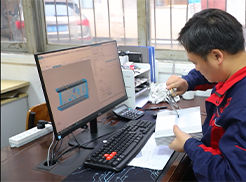This profile is a large, multi-cavity, thin-walled, flat and wide rail car body profile. The maximum circumscribed circle diameter of the profile is D=500mm, and the feeding length is 24.6m. The wall thickness of the profile varies greatly, with the maximum wall thickness of 4.5mm and the minimum The wall thickness is 1.5mm and the profile width is 487.4mm, which is a difficult-to-form profile.
The inner diagonal reinforcement node corresponds to the center position of the diverter hole; the diverter hole area gradually increases from the center, and the distance between the diverter hole and the profile also gradually decreases; the closer to the two sides, the greater the reduction of the diverter bridge, and the width of the diverter bridge gradually narrows .
The cavity design technology of graded flow diversion and multi-stage flow diversion has passed:
a: Design diversion chambers and diversion troughs hierarchically;
b: Design different bridge width and bridge height combinations, and cooperate with layered diversion cavities and diversion grooves to adjust the metal flow, ensure uniform flow and complete filling of metal in the width direction of the mold, and reduce extrusion resistance at the same time.
The welding chamber adopts a secondary welding chamber structure. The height of the primary welding chamber is 34mm. The butterfly welding chamber structure is selected; the height of the secondary welding chamber is 6mm. At the connection node of the profile diagonal bars, the width of the secondary welding chamber is appropriately narrowed; the secondary welding chamber is expanded at both ends of the profile. wide; the secondary welding size of the flat mold part of the profile is also narrow.
The size of the die hole is determined to be 1.01 times the size of the profile, and appropriate correction values are added to the partial section of the profile based on the empirical coefficient;
Determine the part under the diverter bridge, far away from the diverter hole, the narrowest die hole, and the most difficult part to feed as the lowest part of the working belt. The exit end of the mold core working belt is designed to be 1.5-2.0mm longer than the lower die hole working belt.
During the extrusion molding process, aluminum alloys undergo multiple cross-coupling stages such as heating, overall flow, shunting, welding, shaping, and cooling. It is basically impossible to understand the characteristics of aluminum alloys using physical experiments and existing measuring instruments and methods. Forming mechanism and deformation rules. The use of simulation technology can simulate the extrusion molding process, reveal the flow rules of metal and the distribution and changes of various physical field quantities, which can be used to guide the optimization and design of molds, thereby reducing the number of actual mold trials and reducing the cost of mold trials. .
Mold repair measures: Carefully polish the working belt between the mold cores with flattening and sandpaper to ensure the verticality and surface roughness of the working belt; use a grinding gun to grind and enlarge the shunt holes and mold bridges corresponding to the deviated walls to increase the alignment. Metal supply for thin areas.
The large surface of profile A is slightly concave and the wall thickness is 0.15mm thinner than the required tolerance; the upper corner, lower corner and vertical ribs of B are 0.15mm, 0.10mm and 0.2mm thinner respectively.
Except for the wall thickness of the small claw shown in red mark, which is 0.1mm thinner than the lower tolerance, the dimensions of other parts of the profile are within the required tolerance range. The first trial mold of the red claw area was too thin and small, and the corresponding shunt hole and mold bridge were not polished properly during the first mold repair, resulting in a slightly insufficient supply of material and the wall thickness was still 0.1mm thin. Mold repair measures: Continue to use the grinding gun to grind and expand the upper mold shunt holes and mold bridges corresponding to the thinner ribs, and increase the metal supply to the thinner areas.
After the repaired mold is assembled, it is put on the machine again for extrusion. The surface of the aluminum alloy profile extruded from the third trial mold is smooth and bright, with no abrasions, scratches and obvious extrusion lines. The flatness and curvature of the profile are everywhere. , twist degree and cross-sectional size all meet the requirements. After the successful mold trial, the subsequent production of the mold successfully extruded 58 tons.


